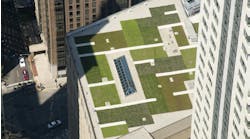Start Preparing Your Facility This Fall For Next Summer
July 2019 was the hottest July and the hottest month on record globally since temperature records began, according to the National Oceanic and Atmospheric Administration. It also found that the year-to-date globally averaged land surface temperature was 2.63°F above the 20th century average. As many property managers know only too well, rising temperatures also mean rising energy bills, as they struggle to keep buildings comfortable for workers.
To make matters worse, commercial buildings in cities are especially challenging, since the heat from black roofs, as well as other factors—such as asphalt roads, densely spaced buildings, and bus and car exhausts—create what is known as heat islands. These are built-up urban areas that experience significantly higher temperatures than surrounding areas.
So how can you work to lower cooling and energy costs when the heat island index is the talk of the office? There are several key activities you can take in the fall so that when the summer rolls around you’re able to conserve as much energy as possible, while keeping your building more comfortable for workers.
Replace Roofing Material
Replacing your roofing material. As building owners and facility managers work furiously to keep buildings cool through air conditioning systems that are working on overdrive, rooftop materials can play a major role in keeping heat at bay, since much of a building’s heat comes directly from the sun’s rays.
While some of this heat gets reflected by the roof, a good portion of it gets absorbed and transferred to the building below, significantly increasing internal temperatures and, in turn, driving up the cost to maintain a comfortable temperature for people. Black or dark roofs retain more heat, absorbing both visible and nonvisible light that can reach temperatures of 150 F or more in the summer, according to the Department of Energy.
Reducing heat on roofs is one of the better ways to reduce building heat. Heat-reflecting cool paints are an effective solution for keeping roofs cool and are being required in many municipalities. Some can reduce both surface temperatures and internal ambient temperatures by 35F.
BUILDINGS Podcast
Tips to Combat Heat Island Effect Around Your Building
Switch Lighting
While LED has emerged as an energy efficient way to light up buildings, there have been concerns that too much blue light in LED light bulbs can affect mood and disease-fighting abilities.
Today, brilliantly healthy LED light panels, can maintain energy efficiency while maximizing the health of those under them. New LED lighting can offer the invisible stimulus that maintains workers’ circadian rhythms, but it does so by converting, not filtering, existing blue LED so energy efficiency isn’t sacrificed.
Engage Occupants
When planning conservation efforts to reduce energy usage in your building, it’s important to map out your strategy and goals and stick to your plan. This means clearly articulating what those energy-saving goals are to the entire staff and involving them in it.
Remind them about the small measures they can take to decrease energy consumption, such as by shutting off lights, keeping blinds drawn, avoiding window fans and keeping doors shut to the outdoors.
Plant Trees and Other Vegetation
In many regions, fall is a good time to plant grass seed. Planting ground covering and trees to provide shade in outdoor areas can help to keep areas cooler in an eco-friendly way, while reducing air and surface temperatures.
A study by Brian Stone of Georgia Tech’s School of City and Regional Planning estimated that by planting more vegetation and using reflective building materials, the cities of Philadelphia, Atlanta and Phoenix could significantly prevent many of the increased fatalities expected from urban heat islands and climate change in 2050.
Conduct an Energy Audit
An energy audit can systematically identify opportunities to reduce energy use in your facility and, as a result, decrease building operating costs.
Using independent firms or conducting an audit on your own, you can determine:
- Determine your facility’s average energy consumption over the course of a set period
- Examine specific energy streams and how they contribute to usage
- Compare energy usage against similar facilities
You can also look for energy-efficient rebates for use of ENERGY STAR-certified products, or through local utilities providers.
Scientists across the globe concur that weather is getting more extreme, because of to global climate warming, but it doesn’t mean you have to break the bank with energy costs.
Autumn provides a perfect opportunity—before the harshness of winter storms and the heat waves of summer—to regroup and proactively plan out a strategy to reduce summer energy costs through more innovative roofing and lighting options, as well as landscaping materials. Not only will it curb costs, but it could possibly extend the life of your HVAC system, which may not have to work in a constant state of overdrive.
About the Author:
Two handpicked articles to read next:


